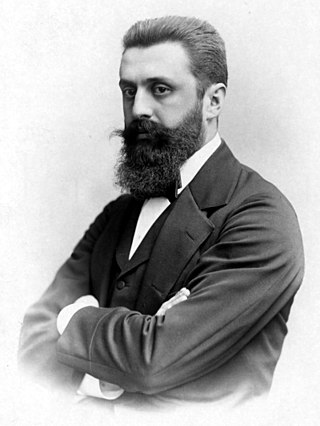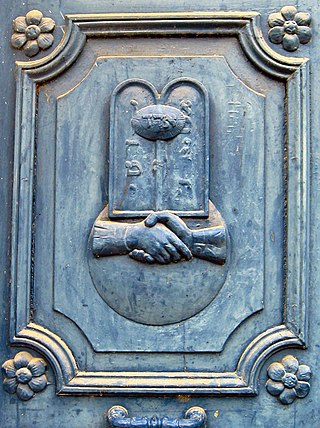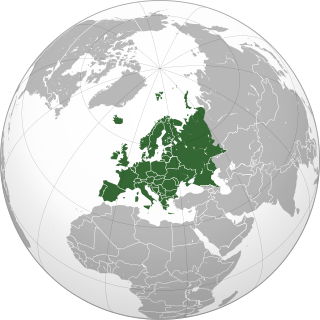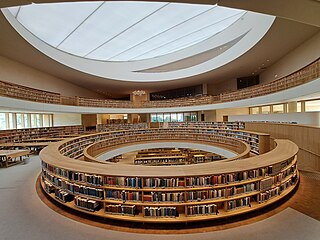
Zionism is a nationalist movement that emerged in the 19th century to enable the establishment of a homeland for the Jewish people in Palestine, a region roughly corresponding to the Land of Israel in Jewish tradition. Following the establishment of the modern state of Israel, Zionism became an ideology that supports "the development and protection of the State of Israel".

The Romaniote Jews or the Romaniotes are a Greek-speaking ethnic Jewish community native to the Eastern Mediterranean. They are one of the oldest Jewish communities in existence and the oldest Jewish community in Europe. The Romaniotes have been, and remain, historically distinct from the Sephardim, some of whom settled in Ottoman Greece after the expulsion of Jews from Spain and Portugal after 1492.

Ashkenazi Jews, also known as Ashkenazic Jews or Ashkenazim, constitute a Jewish diaspora population that emerged in the Holy Roman Empire around the end of the first millennium CE. They traditionally spoke Yiddish and largely migrated towards northern and eastern Europe during the late Middle Ages due to persecution. Hebrew was primarily used as a literary and sacred language until its 20th-century revival as a common language in Israel.
Yevanic, also known as Judaeo-Greek, Romaniyot, Romaniote, and Yevanitika, is a Greek dialect formerly used by the Romaniotes and by the Constantinopolitan Karaites. The Romaniotes are a group of Greek Jews whose presence in the Levant is documented since the Byzantine period. Its linguistic lineage stems from the Jewish Koine spoken primarily by Hellenistic Jews throughout the region, and includes Hebrew and Aramaic elements. It was mutually intelligible with the Greek dialects of the Christian population. The Romaniotes used the Hebrew alphabet to write Greek and Yevanic texts. Judaeo-Greek has had in its history different spoken variants depending on different eras, geographical and sociocultural backgrounds. The oldest Modern Greek text was found in the Cairo Geniza and is actually a Jewish translation of the Book of Ecclesiastes (Kohelet).
The persecution of Jews has been a major event in Jewish history, prompting shifting waves of refugees and the formation of diaspora communities. As early as 605 BCE, Jews who lived in the Neo-Babylonian Empire were persecuted and deported. Antisemitism was also practiced by the governments of many different empires and the adherents of many different religions (Christianity), and it was also widespread in many different regions of the world.
The rise of the Western notion of nationalism in the Ottoman Empire eventually caused the breakdown of the Ottoman millet system. The concept of nationhood, which was different from the preceding religious community concept of the millet system, was a key factor in the decline of the Ottoman Empire.
Italian Jews or Roman Jews can be used in a broad sense to mean all Jews living in or with roots in Italy, or, in a narrower sense, to mean the Italkim, an ancient community living in Italy since the Ancient Roman era, who use the Italian liturgy as distinct from those Jewish communities in Italy dating from medieval or modern times who use the Sephardic liturgy or the Nusach Ashkenaz.

The Alliance israélite universelle is a Paris-based international Jewish organization founded in 1860 with the purpose of safeguarding human rights for Jews around the world. It promotes the ideals of Jewish self-defense and self-sufficiency through education and professional development. The organization is noted for establishing French-language schools for Jewish children throughout the Mediterranean, Iran, and the former Ottoman Empire in the 19th and early 20th centuries.

The history of the Jews in Europe spans a period of over two thousand years. Jews, an Israelite tribe from Judea in the Levant, began migrating to Europe just before the rise of the Roman Empire. Although Alexandrian Jews had already migrated to Rome, a notable early event in the history of the Jews in the Roman Empire was the 63 BCE siege of Jerusalem.
Azariah ben Moses dei Rossi was an Italian physician, Jewish rabbi, and scholar. He was born at Mantua in c. 1511; and died in 1578. He was descended from an old Jewish family which, according to tradition, was brought by Titus from Jerusalem. He was known among Jews as Azariah min-Ha'adumim, a play on his name as well as a possible allusion to the fact that he lived in Catholic Italy, Rome being regarded as a spiritual heir of Esau. Combining an insatiable desire for learning with remarkable mental power, Dei Rossi early in life became exceptionally proficient in Hebrew, Latin, and Italian literature. He became known for his critical thinking and erudition. He studied simultaneously medicine, archeology, history, Greek and Roman antiquities, and Christian ecclesiastical history. When about the age of thirty he married and settled for a time at Ferrara. Later he was found at Ancona, Bologna, Sabbionetta, and again at Ferrara. In 1570 a terrible earthquake visited the last-named city and caused the death of about 200 persons. The house in which Dei Rossi lived was partly destroyed; but it happened that at the moment he and his wife were in their daughter's room, which remained uninjured. During the disturbances consequent upon the earthquake Dei Rossi lived in an outlying village, where he was thrown into association with a Christian scholar, who asked him if there existed a Hebrew translation of the Letter of Aristeas. Dei Rossi answered in the negative, but in twenty days he prepared the desired translation, which he entitled Hadrat Zekenim. His account of the earthquake, written shortly after, is entitled Kol Elohim; he regarded the earthquake as a visitation of God, and not merely as a natural phenomenon.
Richard I. Cohen, also known as Richard Yerachmiel Cohen is a professor of history, presently holding the Paulette and Claude Kelman Chair in French Jewry Studies in the Department of Jewish History at the Hebrew University of Jerusalem. He specializes in the history of Jews in Western and Central Europe in the modern period, in particular the Jews of France, art history, Jewish historiography, and The Holocaust.

In the early modern era, European Jews were confined to ghettos and placed under strict regulations as well as restrictions in many European cities. The character of ghettos fluctuated over the centuries. In some cases, they comprised a Jewish quarter, the area of a city traditionally inhabited by Jews. In many instances, ghettos were places of terrible poverty and during periods of population growth, ghettos had narrow streets and small, crowded houses. Residents had their own justice system. Around the ghetto stood walls that, during pogroms, were closed from inside to protect the community, but from the outside during Christmas, Pesach, and Easter Week to prevent the Jews from leaving at those times.

Israel Gutman was a Polish-born Israeli historian and a survivor of the Holocaust.

Yohanan Petrovsky-Shtern is an American historian, philologist and essayist, noted in particular for his studies of the institution of Cantonism, his critique of Aleksandr Solzhenitsyn's controversial two volume-work about Jews in Russia, Two Hundred Years Together, as well as translations of Jorge Luis Borges' works into Russian. He is the Crown Family Professor of Jewish Studies and a Professor of Jewish History in History Department at Northwestern University where he teaches Early Modern, Modern and East European Jewish history.

The history of the Jews in Calabria reaches back over two millennia. Calabria is at the very south of the Italian peninsula, to which it is connected by the Monte Pollino massif, while on the east, south and west it is surrounded by the Ionian and Tyrrhenian seas. Jews have had a presence in Calabria for at least 1600 years and possibly as much as 2300 years. Calabrian Jews have had notable influence on many areas of Jewish life and culture. The Jews of Calabria are virtually identical to the neighbouring Jews of Sicily but are considered separate. However, the Jews of Calabria and the Jews of Apulia are historically the same community, only today are considered separate. Occasionally, there is confusion with the southern Jewish community in Calabria and the northern Jewish community in Reggio Emilia. Both communities have always been entirely separate.

Jews or Jewish people are an ethnoreligious group and nation originating from the Hebrews or Israelites of the ancient Near East, and whose traditional religion is Judaism. Jewish ethnicity, religion, and community are highly interrelated, as Judaism is an ethnic religion, although not all ethnic Jews practice it. Despite this, religious Jews regard individuals who have formally converted to Judaism as part of the community.
Elijah ben Elkanah Capsali was a notable rabbi and historian. Capsali, an important historian of Muslim and Ottoman history, has a medieval historical approach, with early modern subject matter. Capsali's chronicle may be the first example of a diasporic Jew writing a history of their own location (Venice).
African Americans in Israel number at least 25,000, comprise several separate groups, including the groups of African American Jews who have immigrated from the United States to Israel making aliyah, non-Jewish African Americans who have immigrated to Israel for personal or business reasons, pro-athletes who formerly played in the major leagues in the United States before playing in Israel on local basketball and other sports teams, as well as foreign students studying in Israeli universities, businessmen, merchants, and guest workers, along with Israeli citizens of African American ancestry. African Americans have served in the Israel Defence Force, and have largely been accepted and into Israeli society, and have represented Israel in numerous international forums such as the Olympic Games, and the Eurovision Song Contest. African American-Israelis have had a major cultural impact in Israel, particular in the arts and culture, music and sports. In addition, there as a large community of Black Hebrew Israelites numbering at least 5,000 people, who originally immigrated to Israel from Chicago in the 1960s, and live mostly in the southern Israeli town of Dimona.
Dan Michman is a Jewish historian. He is the head of the International Institute for Holocaust Research at Yad Vashem in Jerusalem and incumbent of the John Najmann Chair of Holocaust studies.

Modern Jewish historiography is the scholarly analysis of Jewish history into the modern era. While Jewish oral history and the collection of commentaries in the Midrash and Talmud are ancient, with the rise of the printing press and movable type in the early modern period, Jewish histories and early editions of the Torah/Tanakh were published which dealt with the history of the Jewish religion, and increasingly, national histories of the Jews, Jewish peoplehood and identity. This was a move from a manuscript or scribal culture to a printing culture. Jewish historians wrote accounts of their collective experiences, but also increasingly used history for political, cultural, and scientific or philosophical exploration. Writers drew upon a corpus of culturally inherited text in seeking to construct a logical narrative to critique or advance the state of the art. Modern Jewish historiography intertwines with intellectual movements such as the European Renaissance and the Age of Enlightenment but drew upon earlier works in the Late Middle Ages and into diverse sources in antiquity.










